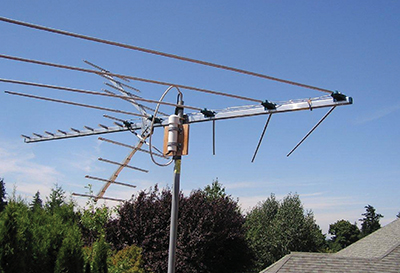Probable Causes and Solutions Found for Poor Reception

Charles W. Rhodes
This month I want to report an unusual DTV reception problem that I recently experienced. I did not write this up until I learned from another retired Tektronix engineer that he could not receive one of our local DTV signals with a rooftop antenna. He asked me about probable causes and I told him of my experience. He reported that by replacing his balun he now receives all local stations. With a score of two out of two, perhaps others may have this problem, too, and have not even suspected the cause. Whoever thinks about baluns?
All rooftop antennas were designed for 300-ohm twin lead. As everyone now uses 75 ohm coaxial cable for their downlead, most outdoor antennas come with a balun, which has an input impedance of 300 ohms (matching the output impedance of the rooftop antenna). The balun transforms from 300 ohms to 75 ohms by means of a balanced-to-unbalanced transformer. It is called a “balun to unbalanced” device.
This matches the 75 ohm impedance of RG 59 and RG6-U coax cables. The insertion loss of these baluns in less than 1 dB, but mine measured over 7 dB. It was full of water! I suggested that perhaps the engineer’s problem might be a “water-logged” balun.
He has just informed me that his balun was indeed defective and, upon replacing it, he now receives all our local stations. He sent the defective unit to me and I discovered an open winding, which I suspect was due to corrosion, again due to rain water.
When you examine one of these baluns it appears to be water-tight, but with exposure to both rain and sun over time, water may get inside and ruin it.
I suspect water-logged baluns will be just as lossy at high VHF frequencies as we have found them to be for UHF channels. I also expect that there are many old baluns out there that should be replaced.
The professional video industry's #1 source for news, trends and product and tech information. Sign up below.
As shown in Fig. 1, when I replaced my wet balun, I installed the new one in a PVC pipe. The 1-1/4-inch PVC pipe has a PVC pipe cap cemented in place and the balun is now out of the weather and out of the sun, too.
My friend did the same thing, so neither of us will ever have to do it again.
F-CONNECTOR PROBLEMS
While on this subject of improving DTV reception, a colleague and I have found that in the daily checking of our RF test bed, which feeds DTV signals to 26 DTV converter boxes, one or more of them exhibits abnormally low sensitivity.

Fig. 1: Rain-proof enclosure of PVC pipe for the new balun mounted on the antenna mast. The white cable is RG6-U to the receiver. The dark flat ribbon is the 300-ohm twin lead from the antenna to the balun inside the new enclosure.
The problem is solved either by tightening the F-connector or by loosening the Fconnector, rotating the coax cable back and forth a few times and then re-tightening the F-connector. Just finger tight is not satisfactory, we’ve found. We use a small wrench.
I would like to hear from my readers about their own experiences with F-connectors and baluns. Many folks out there have a marginal signal on one or more channels. We’ve seen a change in sensitivity of up to 3 dB when we attack the F-connectors as outlined above.
In our testing regimen, we start with the desired signal below threshold and increment the D power in small steps to find the threshold power of each unit every time we run experiments. That is how we detect these F-connector problems.
I suspect many of your viewers are experiencing intermittent reception due either to wet baluns or poor connections between the coax and the receiver, or both. I’d like to pass your experiences along to other readers.
Stay tuned.
Charles Rhodes is a consultant in the field of television broadcast technologies and planning. He can be reached via email atcwr@bootit.com.
